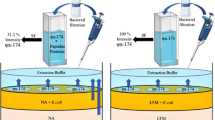Abstract
Metals are thought to play a role in the structure of many viruses. The crystal structure of the T=3 icosahedral cowpea chlorotic mottle virus (CCMV) suggests the presence of 180 unique metal-binding sites in the assembled protein cage. Each of these sites is thought to involve the coordination of the metal by five amino acids contributed from two adjacent coat protein subunits. We have used fluorescence resonance energy transfer (FRET), from tryptophan residues proximal to the putative metal-binding sites, to probe Tb(III) binding to the virus. Binding of Tb(III) was investigated on the wild-type virus and a mutant where the RNA binding ability of the virus was removed. Tb(III) binding was observed both in the wild-type virus (K d=19 μM) and the mutant (K d=17 μM), as monitored by the increase in Tb(III) fluorescence (545 nm) and concomitant decrease in tryptophan fluorescence (342 nm). Competitive binding experiments showed Ca(II) to have about 100-fold less affinity for the binding sites (K d=1.97 mM). This is the first direct evidence of metal binding to the putative metal-binding sites, originally suggested from the crystal structure of CCMV.








Similar content being viewed by others
References
Durham AC, Hendry DA (1977) Virology 77:510–519
Hull R (1977) Virology 79:58–66
Durham AC, Bancroft JB (1979) Virology 93:246–252
Chiu W, Burnett R, Garcea R (eds) (1997) Structural biology of viruses. Oxford University Press, Oxford
Skehel JJ, Wiley DC (2000) Annu Rev Biochem 69:531–569
Bancroft JB, Hiebert E, Rees MW, Markham R (1968) Virology 34:224–239.
Fox JM, Johnson JE, Young MJ (1994) Sem Virol 5:51–60
Zlotnick A, Aldrich R, Johnson JM, Ceres P, Young MJ (2000) Virology 277:450–456
Ahlquist P (1999) In: Granoff A, Webster RG (eds) Encyclopedia of virology. Academic Press, New York, pp 198–204
Bancroft JB, Hiebert E (1967) Virology 32:354–356
Zhao X, Fox JM, Olson NH, Baker TS, Young MJ (1995) Virology 207:486–494
Speir JA, Munshi S, Wang G, Baker TS, Johnson JE (1995) Structure 3:63–78
Johnson JE, Speir JA (1997) J Mol Biol 269:665–675
Douglas T, Strable E, Willits D, Aitouchen A, Libera M, Young M (2002) Adv Mater 14:415–418
Sambrook J, Fritsch EF, Maniatis T (1989) Molecular cloning: a laboratory manual. Cold Spring Harbor Laboratory Press, Cold Spring Harbor, NY
Horrocks WD, Sudnick D (1981) Acc Chem Res 14:384–392
Cheng Y, Prusoff WH (1973) Biochem Pharmacol 22:3099–3108
Incardona NL, Flanegan JB, McKee S (1973) Virology 53:204–214
Liddington RC, Yan Y, Moulai J, Sahli R, Benjamin TL, Harrison SC (1991) Nature 354:278–284
Acknowledgements
This work was supported in part by the National Institutes of Health (RO1 GM61340) and the Office of Naval Research.
Author information
Authors and Affiliations
Corresponding author
Rights and permissions
About this article
Cite this article
Basu, G., Allen, M., Willits, D. et al. Metal binding to cowpea chlorotic mottle virus using terbium(III) fluorescence. J Biol Inorg Chem 8, 721–725 (2003). https://doi.org/10.1007/s00775-003-0470-7
Received:
Accepted:
Published:
Issue Date:
DOI: https://doi.org/10.1007/s00775-003-0470-7




